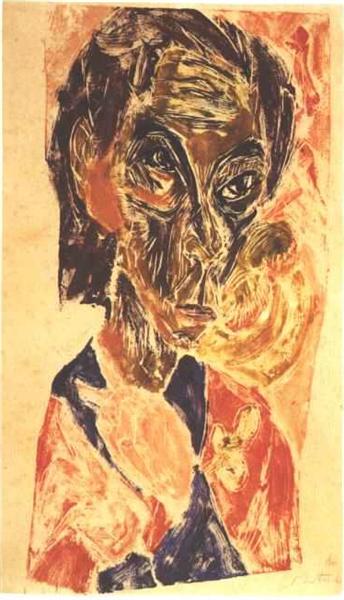Description
Ernst Ludwig Kirchner's "head of the sick", created in 1917, is a powerful and moving representation that reflects the anguishing existence and suffering of the individual in a world in crisis. Kirchner, as one of the most prominent exponents of German expressionism, achieves through this painting encapsulate a deep psychological concern, a recurring theme in his work and in the context of the first half of the 20th century.
The composition of the work is remarkable for its focus on the portrait of the sick man, who is presented frontally, with his face dominating the canvas on a kind of emotional isolation. This portrait not only reveals the physical fragility of the subject, but also refers to the fragility of the human soul in times of turbulence. The empty and melancholic look of the character becomes a mirror that reflects the tensions of a society torn by war and modern transformations. Kirchner, who experienced mental and physical health problems, infuses in the work an emotional burden that transcends the personal and becomes a comment on the desolation of the individual in situations of anguish.
The use of color in "patient head" is particularly shocking. Kirchner applies vibrant and contrasted tones, evident in the green and blue tones that dominate the palette. These colors, far from transmitting tranquility, contribute to the work an atmosphere of discomfort and tension. The background, an imposing green, is juxtaposed with the colors of the patient's skin, underlining his state of vulnerability. This chromatic choice is not accidental; Expressionism is characterized by the use of unnatural colors to evoke feelings, and in this work Kirchner achieves a visceral connection with the viewer, who cannot avoid feeling an emotional response to the representation of human suffering.
In terms of style, Kirchner incorporates an energetic and gestural technique that reinforces the emotional intensity of the work. The visible brushstrokes and an almost violent application of color emphasize the sense of anguish and agitation that permeates the portrait. This way of painting is testimony of the characteristic style of the artist, where the figurative and the abstract are merged, distorting reality to reflect its subjective interpretation and the clamor of the tormented soul.
The work can also be framed within the historical context of its creation. In 1917, Europe faced the devastating consequences of World War I, and art became a means of exploration of human experiences torn by conflicts and loss. Kirchner, whose life was marked by physical illness and psychological suffering, uses his art as a vehicle of expression of his personal pain and collective anguish of his time.
"Head of the sick" is not only a portrait of an individual, but an allegory about the human condition in a period of crisis. Kirchner, through his particular expression, manages to connect the individual experience of suffering with the widest narrative of an endangered society. This work invites a reflection on the fragility of existence and the search for meaning in moments of despair, consolidating itself as an essential piece in the development of expressionism and in the emotional legacy of the art of the twentieth century.
KUADROS ©, a famous paint on your wall.
Hand-made oil painting reproductions, with the quality of professional artists and the distinctive seal of KUADROS ©.
Art reproduction service with satisfaction guarantee. If you are not completely satisfied with the replica of your painting, we refund your money 100%.

